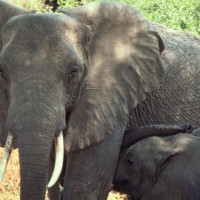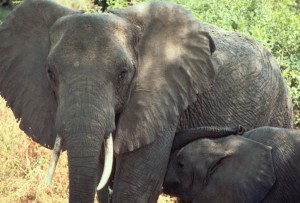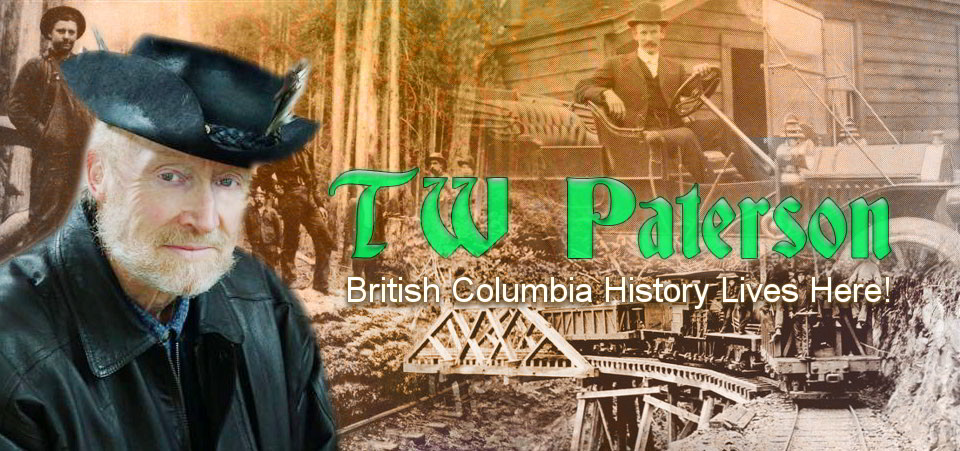Cranbrook’s Great Elephant Hunt of 1926

From far and wide they came, that hot summer of 1926. Expectant children and nostalgic adults, by car, train and wagon, they poured into Cranbrook for that greatest of occasions, Circus Day.
But the colossal extravaganza that Sells-Floto Circus inadvertently staged was to make history and completely overshadow any of the acts it had headlined beneath its big-top.
Those British Columbians who were there long remembered with affection and a smile that riotous time when seven grey monsters terrorized a countryside–the Great Elephant Hunt.

Although frightened and hungry, most of the runaway elephants were tame–but those living on the outskirts of Cranbrook didn’t know that!
For most of its western tour, Sells-Floto had been troubled by its 14 pachyderms. The nervous giants had created disturbances at Edmonton and Calgary, but it was the high altitude and smoke from forest fires–some maintain a barking dog was to blame–that triggered the stampede at Cranbrook when they were being unloaded from their boxcars.
Instantly, the quiet community was plunged into bedlam as 14 trumpeting elephants charged through the streets in every direction, ears wide, trunks erect. Within seconds, doorways, culverts–anything that afforded cover–were crowded with scrambling circus hands and spectators. Several roustabouts who’d not jumped aside quickly enough were slightly injured and had to be rushed to hospital.
The great chase was on!
Hours later, reports of enormous footprints were flooding in from as far away as Yahk, 40 miles to the south, the lumbering fugitives having made good time by following the Canadian Pacific right-of-way and prompting what’s considered to be the most unusual telegraph message in North American railway history:
All trains East. Keep lookout for elephants on track; advise if sighted from first telegraph office giving location.
Seven were soon safely under wraps, some having been captured in the Cranbrook cemetery. But the remaining seven had scattered even farther as harried circus officials issued contradictory orders, charged madly off in all directions and swallowed aspirin by the bottle.
Delighted newspapers gave the breathless details in glaring headlines:
• Hundreds of men now hunting elephants in B.C.
• Five hunters hospitalized, many others hurt
• Another Indian [sic] has miraculous escape from being gored by rampaging female elephant
Hampering the search most, according to the Cranbrook Courier, were “dense woods, deep ravines and steep hillsides… Luckily no one joining in the chase of the huge beasts has been seriously hurt so far, though several men have been more or less bruised in attempting their capture. In the first rush of their breakaway, Dooley, one of the trainers, received minor injury, and Abel, Kootenay Indian, had an exciting experience when suddenly swept from his horse by one of the runaways which charged him from a thicket.”
As elephant trainer ‘Cheerful’ Gardner flew north from Wichita, Kansas to direct the hunt, circus employees and volunteers scoured the rugged countryside with ropes, nets and chains. Gardner finally arrived by train, his plane having been grounded by poor weather.
In the meantime, much to her regret, Mary, a 60-year-old native woman, had located three of the missing mammals, cows Bessie and Virginia, and the bull Cicero.
With neither newspaper nor radio, Mary hadn’t heard of the notorious escape. When she looked up from her labours in her small orchard to see three towering grey monsters watching her curiously, the old woman almost fainted.
From her perch in an apple tree, Mary watched in awe
Looking about wildly for means of escape, she glanced upward, decided it was the only course, and scrambled up an apple tree to await further developments. Cicero, Bessie and Virginia watched her antics placidly then, scenting the apples Mary had shaken loose in her flight, shuffled forward to pluck the fruit from the grass with their trunks. They proceeded to munch contentedly while Mary watched in awed silence from her perch.
As the monsters continued their repast peacefully, Mary’s terror gave way to a sense of wonder. And a plan. Noticing how they devoured her apples, she began throwing the fruit to the ground, each time farther from her tree. The elephants eagerly followed the succulent missiles, each step taking them that much farther from Mary.
When they’d moved off to what she thought was a safe distance, Mary clambered down and ran as fast as she could to the cabin of her nearest neighbour, Charlie Sunrise, to find he wasn’t home. The fact was, at that very moment, poor Charlie was running for his life.
Earlier, he’d encountered enormous tracks of a shape and size he’d never seen before although he’d hunted bear and cougar for years. But these prints and a wide swathe bulldozed through brush and undergrowth were unbelievable.
Charlie had seen bear and cougar tracks–but nothing like these gigantic prints
Hair tingling, he’d followed the mangled trail for some distance until he came to a thick grove of cedar and hemlock. Suddenly he looked back–to see the cow Tillie, maddened by cold and hunger, charging.
Bugling in fury, the earth trembling beneath her weight, she galloped to the attack. For a split second Charlie stood fast, unable to move, but as the distance between them narrowed with every moment, he began to run.
However, by leaving the comparative shelter of the grove to flee through the tangled undergrowth, he allowed his bellowing attacker to close with every thundering step. On and on he ran, lungs heaving, but he couldn’t stop for breath. On and on came Tillie, now at his heels, trampling young trees and brush.
Breaking into a clearing, Charlie came to a deep gorge spanned by a rickety foot bridge. On the far side, exhausted, he slumped to his knees in despair. He could run no more.
Long seconds passed. A minute.
Still he hadn’t been grabbed skyward and crushed by the snaking trunk and, looking back, Charlie saw the elephant place a tentative foot on the bridge then withdraw. Balefully, the cow looked across the ravine, at the bridge and at Charlie again. Then she slid carefully down one side of the draw and charged eagerly up the other bank, trumpeting victory.
Her earsplitting boast gave way to a scream of outrage when she topped the rise to find Charlie had moved–onto the narrow bridge. Once again, Tillie tested her weight on the span. Once again she realized it couldn’t support her.
Then began an almost comical dance as Charlie inched back and forth across the bridge and the frustrated cow vainly charged up one bank and down the other. Time and again they completed the bizarre performance until Tillie finally tired and, with a last bellow of rage, rumbled off into the trees.
Charlie was alone.
But he waited some time to make sure she’d really departed before venturing off the bridge. Fleeing to town, he told of his narrow escape and heard of Mary’s adventure with Cicero, Virginia and Bessie. When trainers surrounded Mary’s orchard, they found the threesome still there, happily gorging on her fruit. For her loss and ordeal Mary received $300.
“Vicious monsters roam the Rocky Mountains”
Such were the newspaper headlines as the hunt intensified. Anxious circus officials, now worried that someone would be seriously hurt, offered generous cash bonuses to local guides. But the scheme backfired when, paid in advance, the ‘guides’ went on a spree, allowing the fugitives to wander ever farther afield.
The celebrants created more problems when Frieda was captured. As trainers cautiously coaxed the nervous cow up a ramp to her freight car, a rousing cheer from watchers spooked Frieda and sent her galloping down the ramp, down the street and out of sight.
Cursing roundabouts finally recaptured her and again urged her up the ramp–this time in silence.
In the meantime, the murderous Tillie had attacked Charlie Buckbone. He managed to escape when she turned on his horse after ripping the shirt from his back with her lashing trunk.
Tillie had to be tricked into recapture
Circus employees finally tricked her into surrender by using two tamer sisters as decoys. Said the Courier: “Spotted by Indians and finally coaxed into civilization by her keepers, Tillie…was brought into the stockyards here on Sunday. Contrary to general expectations, Tillie, though restless, exhibited no inclination to attack Dooley and Cheerful Gardner, sent by the circus management to assist effecting her capture. Last reports are to the effect that Charlie Ed and Myrtle are ranging in the vicinity of Finlayson’s ranch on the Gold Creek road.”
When keepers bandaged her cut feet in gunny sacks and children treated her with apples, belligerent Tillie’s temper cooled and she accepted captivity without further protest.
Another native man, Salmon Jack, had spotted one of the runaways while picking raspberries with his wife and grandchildren. Instinctively hugging their baskets of berries, they fled to their cabin as the starving elephant, aroused by the berries’ scent, lumbered along behind.
Bolting the door, Jack huddled in a corner with his panic-stricken family as the beast fought to enter the house. Timbers groaned and cracked as the giant rocked the cabin to and fro like a ship at sea with its shoulder. When it thrust its trunk through a broken window to probe the interior, Jack grabbed up an iron poker from his fireplace and brought it down with all his might across the writhing grey snout.
With a banshee wail of pain
The elephant thundered off into the trees, leaving the terrified family to enjoy their escape from what had seemed impending doom.
When trainers at last found Myrtle, they were too late. “Located by Indians at a spot close to the base of Moyie Mountain…she is reported to be a physical wreck, all her toenails are worn off, her knees terribly bruised, and two or three bullet wounds in her hip. It is thought that Indians, panicked by being charged several days ago, fired several shots into her. She was in extremely exhausted condition and in great pain.”
Calmed with morphine injected by a brave trainer, Myrtle was securely chained. Then circus men faced the herculean problem of how to extricate her bulk from the jungle of slash and rock. Myrtle solved the problem for them by dying on the spot of pneumonia, the result of her wounds.
With Myrtle’s demise, Sells-Floto officials had just one fugitive to track down, young Charlie Ed. Most prized of the herd as he was a talented clown, the bull had been suffering from an infected tusk when he escaped and officials worried he’d perish like Myrtle if not found soon.
Happily, Charlie was traced to Smith Lake. The Cranbrook Herald gave the details of his capture. He “recognized [his] own trainer Charlie Morgan, and on hearing his voice whimpered a little, and showing signs of friendliness, was coaxed along with bread.
Two handlers were injured in final wrestling match with Charlie Ed
“The mountain air, however, did apparently make Charlie somewhat more frisky than was anticipated, with the result that, before Morgan and [Spot] Griffith succeeded in getting him properly chained, the former had his shoulder hurt, while Griffith was injured in the ribs. [In the Edmonton melee, Morgan had been ‘laid out’ by the ‘obstreperous Mary’ and hadn’t fully recovered.]
“Charlie was being brought to Cranbrook on Wednesday, and by the courtesy of the Sells-Floto Circus, through their representative here, Mr. A.J. Ironsides, and their assistant manager, Mr. Orville Stewart, the animal will be shown at the Cranbrook Fall Fair the last three days of this week. On this occasion it is the intention to have Charlie Ed re-christened ‘Cranbrook Ed.’ The managers of the circus feel that they would like to do this in recognition of the many courtesies received by them in this city during their stay and subsequent to the loss of their…elephants.’
Later that week, a beaming Mayor T.M. Roberts renamed Cranbrook Ed in a colourful ceremony. The Great Elephant Hunt was history.
When Sells-Floto management totalled the costs of the six-week misadventure, they found themselves out the staggering sum of $50,000. This through the loss of Myrtle, cancelled bookings and compensation for damages and rewards.
Long after that exciting summer, the memory of East Kootenay’s rampaging elephants lived on as, each summer, Pacific Northwest skeet shooters and marksmen traveled to Kimberley to compete and commemorate those outrageous weeks of 1926–British Columbia’s wildest big game hunt ever!

Well done Tom…what marvelous stories of our past. You really make history interesting reading…
do you know if any geraffs escaped. I had heard there was a geraff named Bummer that was found at what is now called Bummer’s Flats.
Hi, Larry: No, I don’t recall any mention in the newspaper accounts of an escaped giraffe(s). I really think the circus folk had enough on their hands with the runaway elephants, don’t you? –TW
Great stories! Never met you, but I have been a VICEG member for some 42 years now! I must pass this one on to my brother, who used to live in Kimberley. Bill
Bill: I haven’t spelunked since my 20s but I did poke about an abandoned coal mine air shaft in the Nanaimo area some years ago.
Yes, I know about ‘dead air,’ which is why I stayed at the entrance. I just wanted to look in, you know?
Besides, my knees ain’t what they used to be although I’m still physically active and reasonably fit. Cheers, and thanks for reading and for commenting. –TWP
My father was the boy with the dog that apparently started the stampede.
Hi, Robin. This is interesting–can you give more details, please? This one of my most popular posts, by the way. –TW
Hi Tom,
What a great story and well written! As a fund-raising project, we the Cranbrook Arts Council Children’s Book Project Committee are working on a story about the Cranbrook area to be illustrated by local artists. Would you be so kind as to allow us to use your article for inspiration? Or can you direct us to your sources and is all the information accurate or somewhat embellished? Again a really well written article. I look forward to hearing from you.
Hi, Laverna: My post is based upon newspaper sources of the day and is about as reliable as one can hope for. I mean, who could embellish such a story?
By all means, use it “for inspiration,” as you put it, in exchange for a credit line and my website address to, hopefully, attract new readers.
Good luck with your project and let me know how it turns out. –TW
i love your article on bulldog, ak edward loughlin, it would make a great canadian movie,just like, mcabe and mrs miller and the one donald sutherland did as a rcmp officer in search of the american out law, played by charles bronson. i would love to write the storyline and playwrite. pretty exciting stuff you have presented. i would also love to see your research on the hanging judge of old fort victoria, the shameful legacy of our first governor general of bc either , lord blanshord, the drug addict, or that guy from the hudson bay that went up north to pull in the indian guy who supposedly killed and robbed a white women, and they killed him before they could take him to trial. also very interesting is that cult in nanaimo, brother john? on an island and apparently some hidden treasure from rich investors, and then theres some lost gold from a train robbery outside clinton south east before cache creek, i know the track as it goes over the river, any way, love your interest in canadian history
Hi Angela: You’ve listed quit a menu of ‘likes’!
I have written about most of them, either in my newspaper columns in the Cowichan Valley Citizen or in some of my books. Speaking of which, a full-length chapter on ‘Bulldog’ Kelly will be in my reprint of Outylaws of the Canadian West, next year.
In a month or so the revised version of my very first book, Treasure, British Columbia, will be released with an updated chapter on Bro. XII, the cult leader who’s believed to have buried jars of gold coins in the De Courcy Islands.
I have a post on ‘Hanging’ Judge Begbie (a misnomer, by the way) on twpaterson.com but I’m going to update it in reference to his now being criticized (even demonized) for his death sentences in the Chilcotin War affair.
You’re right, some of these folks would make for a great movie! Which is precisely why they’re so easy to write about because they were bigger than life.
Pleae keep reading! –TW
My mother-in-law was a little girl at the time and wrote about this incident. It is a fantastic story and you did it justice. Thank You
Thank you, too, Elaine, for commenting. It is one heck of a story–right up there with the saga of Barnum’s ‘Jumbo.’ –TW
My grandfather was a part of the search party for the escaped elephants.
That would have been exciting, I’m sure.